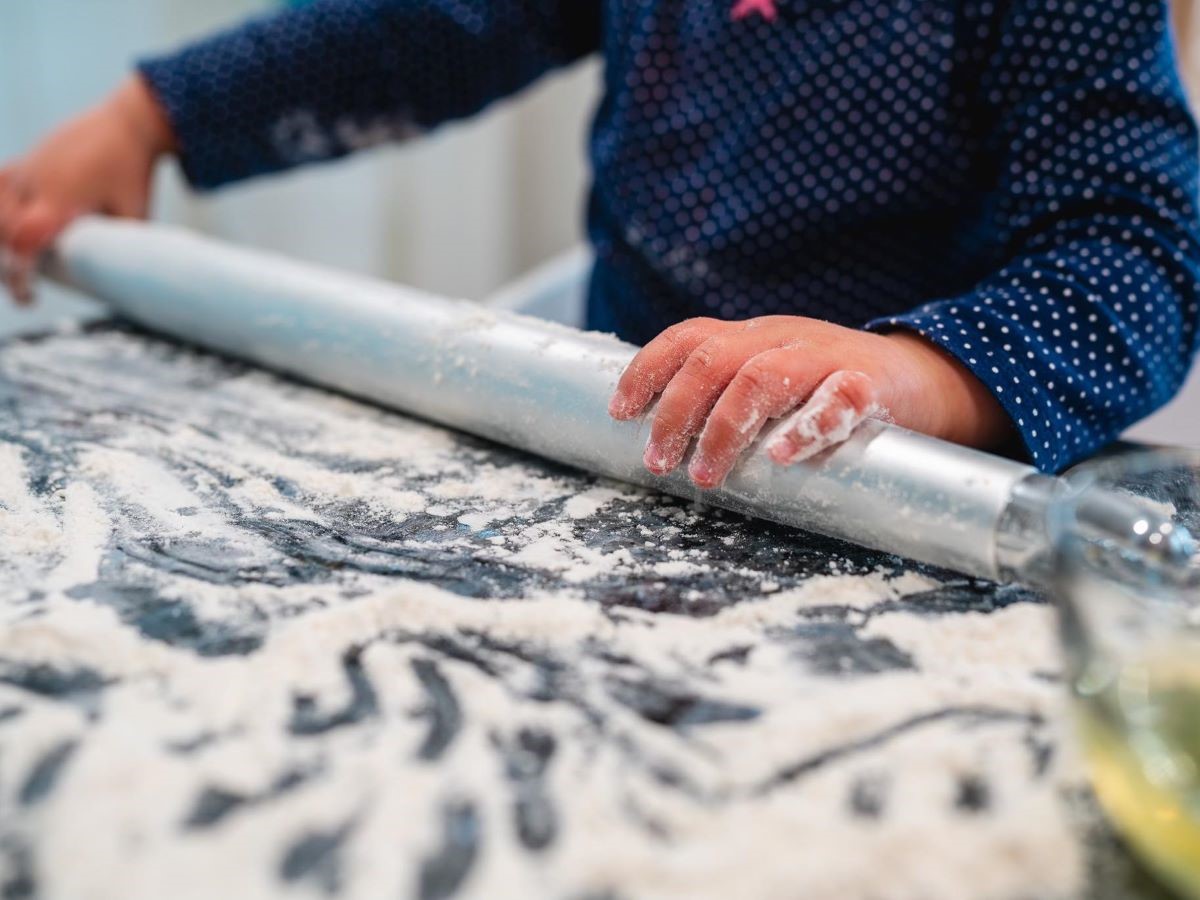I have enjoyed baking for as long as I can remember, and I credit this almost entirely to my mother. She involved me in much of her work in the kitchen while I was growing up, which has led to cozy memories as a child, my first job in a local bakery as a teen, and applicable life skills as an adult. I am so excited to be able to pass these down to my own daughter!
Children Belong in the Kitchen
In my humble opinion, the kitchen is the best and most versatile classroom available! Cooking and baking with our children engages them in early math skills like one-to-one correspondence, counting, arithmetic, measuring, and fractions, as well as executive functioning skills like following step-by-step instructions and time management. It strengthens their motor skills with pouring, scooping, stirring, and wiping up spills. Cooking and baking also lead to sensory explorations through smells, textures, temperatures, and tastes. These opportunities for positive food exposures are shown to reduce picky eating tendencies and encourage a physically and emotionally healthy relationship with food. The kitchen environment naturally provides rich language opportunities for any age group, an outlet for creative expression, and feelings of empowerment and belonging. Your child can absorb all of this and more, all while spending quality time with a loving adult.
If any of this sounds like something you want for your child, but you still feel intimidated by the idea of welcoming them into your kitchen, then you’re in good company. Although I am wholeheartedly convinced that my toddler belongs in the kitchen with me, I am still figuring out how to meet her needs while balancing my own. The two things I have learned so far that help us make the most of our time together in the kitchen are “Process Over Product” and “Preparation Before Invitation.”
Process Over Product
I don’t remember when or where I first heard the phrase “process over product,” but it is now used frequently in our home. I think it perfectly describes the difference between the way adults and young children tend to approach the same task. When I set out to bake something on my own, I have the end product in mind. Ideally, I will be eating warm, gooey chocolate chip cookies in a clean kitchen. My goal is to be neat and efficient, especially when using a familiar recipe. My toddler’s goals are entirely contrary to mine. When we start baking together, nothing is familiar, and everything is fascinating. Ideally, she will be feeling two grains of sugar rubbing between her tiny fingertips, giggling as powdery puffs of flour cloud around the bowl, and using the strength of her entire body to guide a little wooden spoon through the batter. She doesn’t give a hoot whether the kitchen is clean, and I’m not even certain if she understands yet that there will be cookies when we’re finished. It is the process itself that brings her joy, and it is the process itself that she is unconsciously using to develop her own brain and body. And, gosh, is it beautiful to watch.
If I am going to invite my child into the kitchen, then I must adjust my goals. As difficult as it is to accept, I am no longer striving for neatness and efficiency. What matters more to me is to offer my daughter as many opportunities as possible to fully engage in this work with me. This requires observation, trial and error, advanced preparation, accepting the probability of mess, and surrendering to the value of a slow and steady process over a “perfect” product.

Preparation Before Invitation
Remembering “Process Over Product” equips me emotionally, and remembering “Preparation Before Invitation” equips me practically. The more I can prepare our workstation for my daughter prior to her entrance, the more smoothly things will go for both of us. Being under two years old, patience is not yet a skill she has developed. It’s not that she doesn’t want to wait while I gather a dozen ingredients from around the kitchen—it’s that she can’t. By the time I return, she will either be too frustrated to engage or something else exciting will have caught her eye. When I take the time to gather all of our materials on the table, there is a magic moment of immersion. The tools laid out before us entice her, and I get to say, “Yes! I brought out our mixing bowl. Let’s make banana bread together.”
In addition to the ingredients and tools needed for the recipe, I want to bring tools that make the task accessible to my daughter. For example, her kitchen helper, which keeps her safe while standing high enough to work at the kitchen table or counter. I love that one of the mesh sides opens up so that she can climb in herself, adding another layer of independence. I might also pre-measure ingredients into little bowls so that she can simply dump the full contents rather than asking her to relinquish the quarter cup when we need another scoop of cocoa powder. Because I am expecting spills, I will also bring a rag to the table for her to clean up after herself. These kinds of little things can make a big difference in the flow of your child’s work, just as they might for you.
Just as you will for your child when an egg inevitably slips from their hand and splatters on the floor, be forgiving with yourself when your time in the kitchen together doesn’t go perfectly. Through active observation, you can learn from even the most frustrating experience to improve upon the next one. When in doubt, slow down, prepare, and focus on enjoying the process together. No matter how messy your kitchen or how burnt your muffins, know that the quality time you have spent with your child is of great value.
From one GeekMom to another, happy baking!
This post contains Amazon Affiliate links that benefit the author at no cost to you. Thank you!




